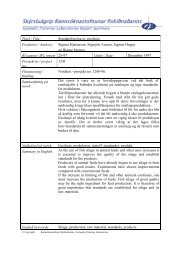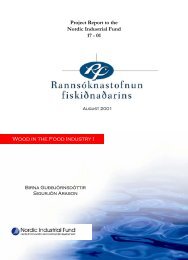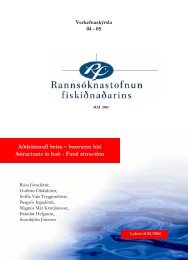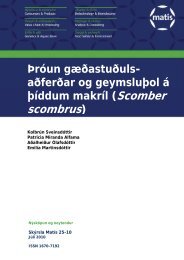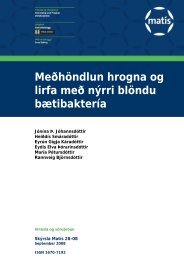Microbiology and Spoilage Trail in Nile Perch (Lates niloticus), Lake ...
Microbiology and Spoilage Trail in Nile Perch (Lates niloticus), Lake ...
Microbiology and Spoilage Trail in Nile Perch (Lates niloticus), Lake ...
You also want an ePaper? Increase the reach of your titles
YUMPU automatically turns print PDFs into web optimized ePapers that Google loves.
<strong>Spoilage</strong> of food means to deprive it of its quality. In totality food spoilage is the results of<br />
metabolic processes that cause food to be undesirable for human consumption, (Adams <strong>and</strong><br />
Moss, 2008; Doyle, 2007; Gram et al., 2002, 1996). Therefore, generally spoilage is a<br />
subjective quality which means products may be accepted or rejected by one person while<br />
the same product may neither be accepted nor rejected by another person. Despite of the<br />
important role of microorganisms <strong>in</strong> food spoilage, the f<strong>in</strong>al decision for reject<strong>in</strong>g the<br />
spoiled food product concerned relies on sensory evaluation, (Gram et al., 2002; Connell,<br />
1975; <strong>and</strong> Re<strong>in</strong>eccius, 1990). This is because the microbial spoilage is normally associated<br />
with a sudden onset which is noticed at late stages of spoilage of products when they<br />
(microbial growth) are at log phases or the exponential growth phases. Therefore, it is<br />
easier to identify chemical compounds that are responsible for a particular sensory <strong>in</strong>dex<br />
such as off odours than the responsible spoilage organisms.<br />
Accord<strong>in</strong>g to Baird Parker, (2000) <strong>and</strong> Anonymous, (1985), the current world food post<br />
harvest <strong>and</strong>/or slaughter losses due to microbial spoilage estimates is about 25% of total<br />
food produced. This is a big loss which can be reduced if the ecology of specific spoilage<br />
organisms is well understood <strong>and</strong> controlled. However, every food product consistit of its<br />
own spoilage micro flora associated with the raw materials, or post contam<strong>in</strong>ation, effect of<br />
central process<strong>in</strong>g parameters <strong>and</strong> storage conditions.<br />
2.3.1 Microbiological spoilage of fresh fish<br />
Despite that muscles of fresh or live fish are sterile, it conta<strong>in</strong>s high load of bacteria on the<br />
surface slime of the sk<strong>in</strong>, on the gills <strong>and</strong> <strong>in</strong> the digestive tract. Bacterial loads on surfaces<br />
(sk<strong>in</strong>) of fish from catch can range from hundreds up to millions per square centimetre (10 2<br />
– 10 7 /cm 2 ); <strong>and</strong> <strong>in</strong> the gills <strong>and</strong> <strong>in</strong>test<strong>in</strong>es <strong>in</strong> the range of 10 3 – 10 9 /g (Adams <strong>and</strong> Moss,<br />
2008; Shewan, 1962; ICMSF, 1980b; Liston et al., 1976). These bacteria <strong>in</strong>clude Gram-<br />
negatives of the genera Pseudomonas, Shewanella, Psychrobacter, Vibrio, Flavobacterium,<br />
<strong>and</strong> Cytophaga <strong>and</strong> some Gram-positives such as coryneforms <strong>and</strong> micrococci. When the<br />
fish is dead, the immune system collapses <strong>and</strong> bacteria are able to multiply. The bacteria on<br />
the sk<strong>in</strong> surface to a large extent colonize the scale pockets <strong>and</strong> <strong>in</strong>vade the flesh by mov<strong>in</strong>g<br />
between the muscle fibres dur<strong>in</strong>g storage. <strong>Spoilage</strong> bacteria dom<strong>in</strong>ate <strong>and</strong> contam<strong>in</strong>ate the<br />
flesh/muscles through damaged parts of flesh <strong>and</strong> cause rapid spoilage of fish. Murray <strong>and</strong><br />
10




